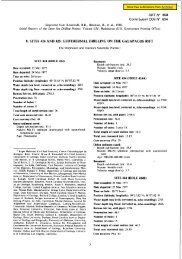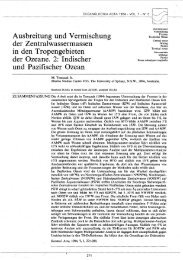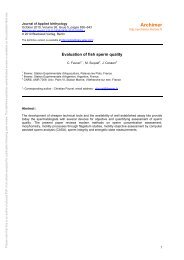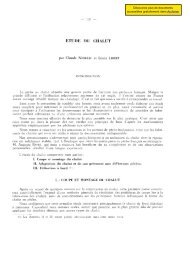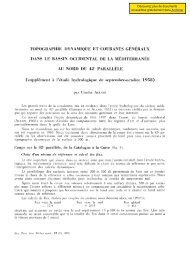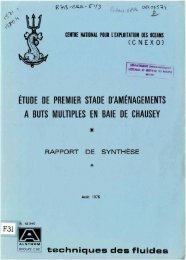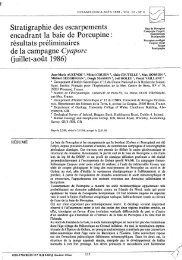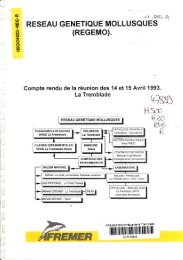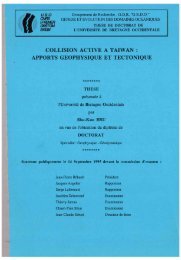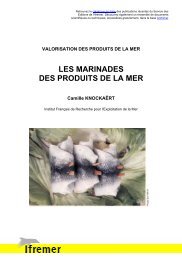Contribution à l'étude de virus de mollusques marins apparentés ...
Contribution à l'étude de virus de mollusques marins apparentés ...
Contribution à l'étude de virus de mollusques marins apparentés ...
You also want an ePaper? Increase the reach of your titles
YUMPU automatically turns print PDFs into web optimized ePapers that Google loves.
740 RENAULT (T.) ET COLLABORATEURS<br />
Size (fi . 50)<br />
Capalda Nucloocapsld6 Envoloplng , Enveloped<br />
virions virions<br />
Bh J.Onm 75" 3.0 nm 991: 0.0 nm 122 ± B.O nm<br />
Nucleus + +<br />
Perfnuclelr space +<br />
Cvtoplaom + + +<br />
Denie bodies + +<br />
Cytoplumle + +<br />
vellel".<br />
Extrllcellul.r + +<br />
TABLE Il. - Occurrence and sile of diffcrent stages of replicalion of oysler herpes-like <strong>virus</strong> in<br />
dirfere"1 cell parts of Crassostrea gigas larvae.<br />
Cap. Ida Nucloocapslda Enveloplnu Enveloped<br />
virions Ylrion.<br />
51%0( ... 50) 81 j: 3.0 nm 75.13.0 nm 100±9.0nm 121 ... 7.0 nm<br />
Nucl.u. + +<br />
Perlnuclear .pace +<br />
Cytopillm + + +<br />
Denllbodln + +<br />
Cytopl •• mlc + +<br />
vellel ..<br />
Exr'Clllular + !<br />
TABLE III. - Occurrence and .size of dirfcrent stages of replicalion of oyster herpes-like <strong>virus</strong> in<br />
diffcre"t cell parts of young oysters, Crassastra gigas.<br />
such similarities are not sufficient on a taxonomic point.<br />
Details of replication are variable within subfamilies [8]<br />
and vary with cell type infected [8, 21 ], time after infection<br />
[18] and <strong>virus</strong> strains [3] . Nevertheless, the nueleic<br />
acid nature of these <strong>virus</strong>es should be confirmed by chemical<br />
analysis.<br />
Several reports of herpes-like <strong>virus</strong>es from marine vertebrates<br />
or invertebrates are found in the literature [2, 12,<br />
13, 19], including herpes-type <strong>virus</strong>es in oysters [l, 7, 10,<br />
14, 16]. The morphological characteristics of the nucleocapsid<br />
of the <strong>virus</strong>es <strong>de</strong>scribed in this sludy are c10sed to<br />
those of the <strong>virus</strong>es reported among Pacific oyster, C.<br />
gigas, larvae in french hatcheries [16] and in New Zealand<br />
[1 4]. The nueleocapsids are similar in dimension to<br />
those <strong>de</strong>tected in European flat oyster, Ostrea edulis, by<br />
COMPS and COCHENNEC [7], in Pacific oyster, C. gigas,<br />
by NICOLAS et al. [15] and in Arnerican oyster, C. virginiea,<br />
by FAR LEY et al. [10], but at 70-75 nm, they are<br />
smaller than the 97 nm of nueleocapsids observed by<br />
HINE et al. [14], among C. gigas in New Zealand (Table<br />
IV). Moreover, mature virions <strong>de</strong>scribed in trus study are<br />
smaller than the 160 to 180 nm of enveloped paraspherical<br />
83<br />
partieles observed in O. edulis [7] and larger than the<br />
90 nm of enveloped partieles reported among French Pacific<br />
oyster larvae [16] (fable IV). Mature partieles noted<br />
into Pacific oyster larvae in New Zealand [14] and in our<br />
report are similar in size (Table IV). However, partieles<br />
sizes are <strong>de</strong>pen<strong>de</strong>nt on the technique of specimen preparation<br />
and measurement.<br />
Elevated temperature and crowding seem to increase the<br />
susceptibility of animais to herpes-like <strong>virus</strong> infections<br />
among Pacific oyster, C. gigas. In<strong>de</strong>ed mortalities associated<br />
with herpes-like <strong>virus</strong>es <strong>de</strong>tection were only observed<br />
during summer in this report. Moreover, the <strong>de</strong>teclion<br />
of herpes<strong>virus</strong>es in arumals held at elevated temperatures<br />
among C. virginiea [10], the occurrence of herpes<strong>virus</strong>es<br />
in summer among C. gigasin Australia [1] and the<br />
observation of mortalities in mid-summer among the same<br />
species reported in New Zealand [14], in France [16] and<br />
in this study, suggest ostreids herpes<strong>virus</strong>es may only <strong>de</strong>velop<br />
and induce mortalities at elevated temperatures, particularly<br />
un<strong>de</strong>r stressed conditions. So high temperatures<br />
appear to favor the spread of the infections or activation<br />
of <strong>virus</strong>es from an occult 10 an overt phase or both.



